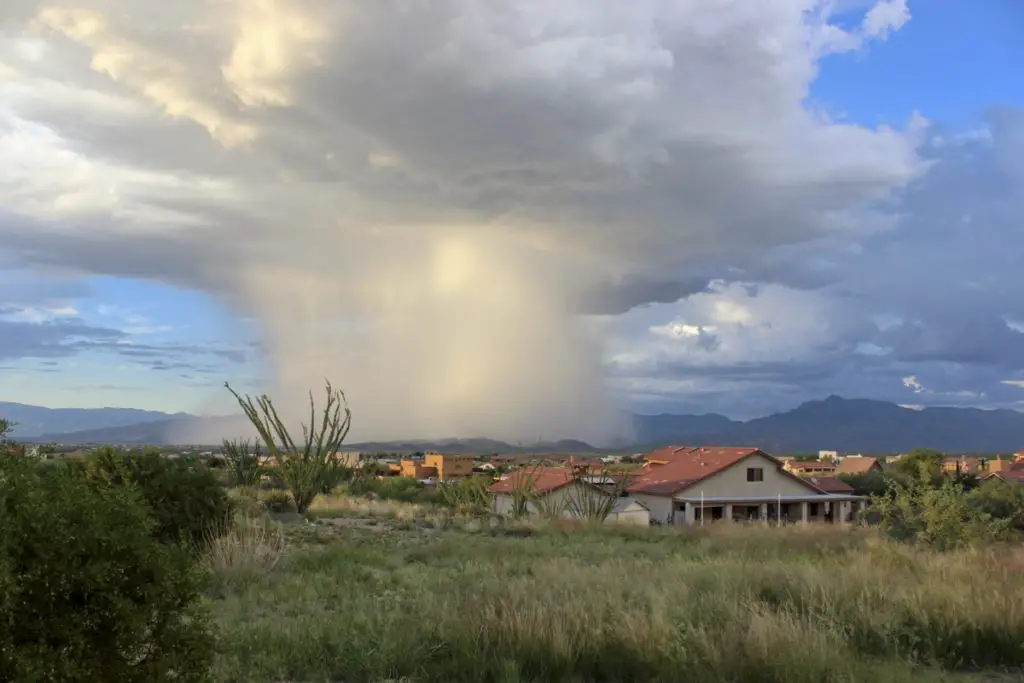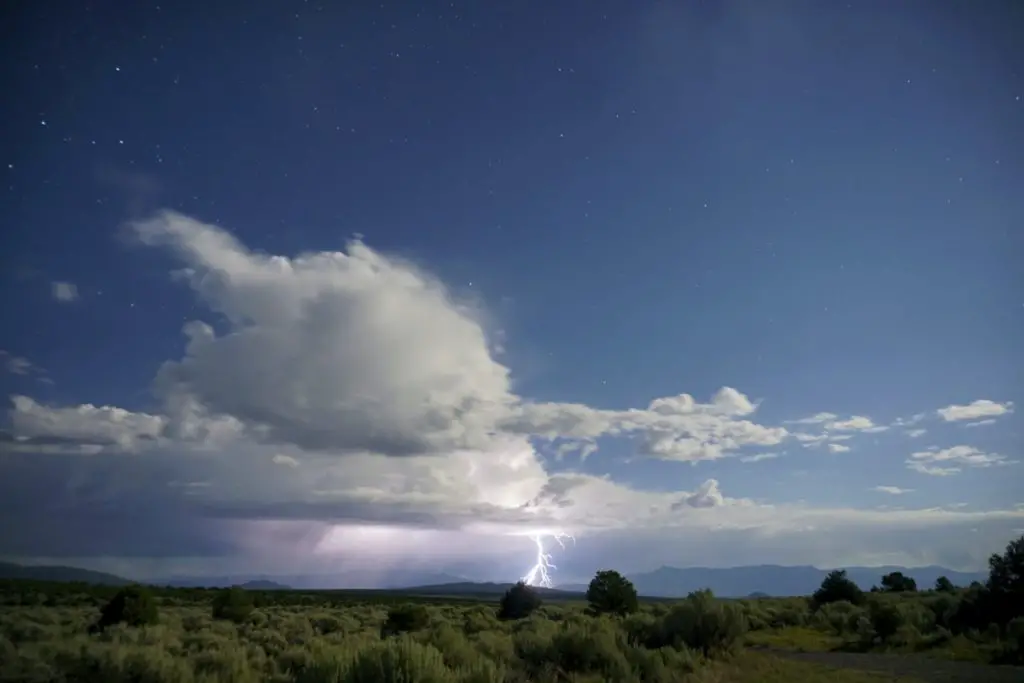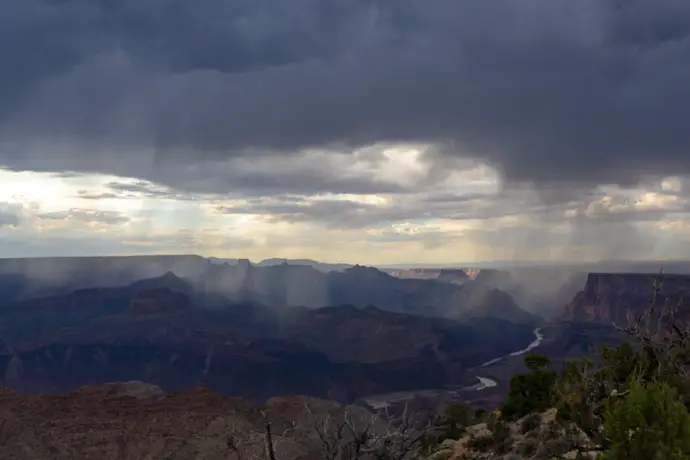Arizona monsoons, also known as the North American monsoon, the Southwest Monsoon, the Mexican monsoon, or the New Mexico monsoon, is a pattern of powerful storms that happens in Northwestern Mexico and the Southwestern United States.
Arizona Monsoon Season is characterized by thunderstorms, dust storms, tornadoes, and flash floods. It takes place from about mid-June until the end of September, and it is essential to know how to stay safe during each type of storm.
Let’s learn more about this fascinating weather phenomenon, including why and when they happen and how to stay safe during the season.
How the Arizona Monsoon Season Begins
Arizona’s monsoon season is brought on by a wind shift. The sun heats the Pacific Ocean and land at different rates. Land warms faster than the ocean, and as the hot air rises, it creates a low-pressure zone that causes the wind to shift.
With the wind heading toward the south during the summer and moisture from the Pacific Ocean and the Gulf of Mexico traveling north, the moisture conditions change. The change of moisture, partnered with the heat during the day, brings on Arizona monsoons.
You can find a detailed and technical explanation here.

What To Expect During A Monsoon
During monsoon season, not only does it become uncomfortably humid, but we can expect a host of other weather conditions.
- Thunderstorms – Lightning and thunder caused by warm, moist air rising into the atmosphere and creating a cumulus cloud. To me, some of the most breathtaking and best lightning storms have occurred here during monsoon season.
- Heavy Rain – As the warm air rises into the atmosphere forming the cumulus cloud, the air cools. The water in the air then falls back to the ground as rain.
- Dust Storms – Also known as “haboobs” happen when the winds from weakening thunderstorms cool and speed up to the surface. These downward strong winds, which can be as fast as 70 miles per hour, then hit the desert floor picking up sand and debris creating a fast-moving wall of sand that can block visibility.
- Flash Floods– Soil isn’t absorbed very well because of Arizona’s dry and hard-packed earth called caliche. Caliche is like a natural cement. As a result, water from a sudden downpour just collects and runs to the dry riverbeds or washes or anything else that can hold water. Water from these washes travel quickly causing floods that can catch hikers unaware or cars can float away.
- Tornadoes – While tornadoes don’t happen often in Arizona, they have happened when a cold air funnel extends to the ground.
Where Did The Term “Monsoon” Come From?
The word “monsoon” comes from the Arabic word “mausim” which became the Portuguese word “moncao”. According to the Arizona State University, the term “mausim” could have come from the early Dutch word “monson”. The term was first used to describe the winds blowing over the Arabian Sea. The literal translation of the word “mausim” is season.
When Is Arizona’s Monsoon Season?
Before 2008, it was said that if the dew point reached 55 for three consecutive days, then the monsoon season had arrived. The dew point measures how much moisture is in the air.
The higher the dew point, the more humid it becomes. Here is a measure of the humidity and your level of comfort if spending time outside, based on the dew point found on weather.gov:
- “Less than or equal to 55: dry and comfortable
- Between 55 and 65: sticky with muggy evenings
- Greater than or equal to 65: lots of moisture in the air, becoming oppressive”
In 2008, it was decided that June 15 would be the start of the monsoon season, and September 30th would be the end. With definite dates, residents of Arizona can prepare for the coming of the monsoon rains.
The wettest monsoon was in 1984 and 9.56 inches of rain fell that year. Arizona’s driest monsoon was in 1924 when only 0.35 inch of rain fell. Monsoon seasons vary from season to season and from city to city.
Why Does Arizona Get Monsoons?
Arizona is bordered by Utah to the North, and shares an international border to the south with Mexico, which is the reason the Arizona monsoon is also called the Mexican monsoon. California and Nevada can be found to its west, with New Mexico to the east.
During the winter, the winds flow from the west or northwest – mainly from California and Nevada. As summer moves in, there’s a change in the wind direction – toward the south. This change then produces a change in the moisture conditions all over the state.
Arizona’s monsoon doesn’t produce heavy rains every day during the season. They have “bursts” and “breaks”. A “burst” usually creates strong thunderstorms. “Breaks” will produce drier air spells over Arizona.

How To Prepare For A Monsoon Storm
During the monsoon season, it’s always good to be prepared as storms come unexpectedly and out of nowhere. Usually they aren’t that serious but it’s always good to be prepared for the just in case scenario…
- In case you’re stuck on the road or there’s a highway closure: keep extra supplies in your car like a flashlight, an emergency kit that includes any prescribed medications, drinking water, and snacks.
- At home, have enough food and drinking water to last you for 72 hours.
- Keep flashlights and candles in case of power failure on hand which definitely happens.
- If you have pets, have a supply of food for them as well.
- Have a first aid kit ready and include sanitizers, wipes, and face coverings to protect you from the dust storms. Make sure that important documents are in a safe place.
- If you live with family, set-up a family plan with instructions on where to meet in case you’re separated. Include everyone’s contact numbers including close family members who don’t live with you.
- Help by being an example and an inspiration in your community. Maybe take first aid classes, and becoming a volunteer, you can, hopefully, convince them to do the same.
Staying Safe During A Monsoon Storm
Safety Tips During Heavy Rains
By subscribing to media or city alerts, you can STAY OFF the roads if you know a storm is coming. However, if you’re caught outside while it’s raining, there are some things you can do to keep yourself safe.
- Turn headlights on, and drive cautiously and slowly, keeping enough space between you and the car in front of you.
- If visibility is almost nonexistent, pull off to the far right side of the road, turn your engine off, and make sure you enable your emergency brake, keeping your foot off the brake pedal. This is especially important if driving through a dust storm.
- If you see an approaching dust storm or heavy rains, and you aren’t confident of your driving abilities, WAIT IT OUT. Exit and wait for the storm to pass through.
- Avoid braking suddenly as this may cause the car to slide.
- Keep a safe distance from larger vehicles like buses and trucks since the spray caused by the larger tires can make it harder to see.
- Ensure you inspect your windshield wipers and replace them if needed.
- Be careful of hydroplaning. If the car slides because you’ve lost traction, ease your foot off the gas pedal and lightly turn your wheel toward your slide, making sure that you don’t brake suddenly.
- Don’t risk your life by going around “Road Closed” signs. If you get stranded and need to be rescued, you may be cited under the Stupid Motorists’ Law. Simply put, if you get caught driving around a barricade to enter a flooded road and need to be rescued, you’ll be charged for the cost of the rescue.
- If your car stalls in a flood, gauge to see how high the flood is. If the water looks like it’s rising, try to get to the roof of your car and call 911.
- Keep sandbags in your home to seal off areas where water may seep in. Also, place sandbags outside to act as a barrier if you live in an area that’s prone to flooding.
- If you’re out camping, do not travel along washes or cross running streams.
- If hiking in canyons, flash floods and falling debris from the slopes are possible so be extra careful ESPECIALLY at night. According to weather.gov, deaths related to flooding happen in cars.
Safety Tips During a Dust Storm or Haboob
If you’re caught in a dust storm, expect that the visibility will be almost nil. Although there usually is a warning sent out, it doesn’t hurt to take some precautions.
- The Arizona Department of Tourism started a phrase – “Pull Aside – Stay Alive”. Checking traffic all around you, start slowing down. If you’re able to, exit the highway. Find a safe place to stop, away from the road’s paved areas – avoid the emergency lane. Turn off all of your lights, including emergency flashers. Set your emergency brakes and take your foot off the brake pedals, and ensure that you still have your seatbelt buckled on. WAIT FOR THE STORM TO PASS.
- Ensure that the windows are sealed. Also, check that the vents in the car are closed so that the dust doesn’t get in. It’s always good to have a mask to cover your nose and mouth, even a makeshift one.
- If you’re home, also check that all windows, blinds, and curtains are shut.
- If your air conditioner is on, turn it off and close all vents.
- If possible, stay in a room without windows until the haboob has passed.
Why Are Haboobs Considered Dangerous
Haboobs can bring on or aggravate health conditions which is why it’s so important to have all your windows closed or wear a mask to cover your nose and mouth. People who suffer from asthma, COPD, diabetes, or chronic bronchitis are the ones who get affected the most by the dust storms.
Another health condition to watch out for if sand is inhaled is Valley Fever. The spores of fungi that live in certain areas of the world, Arizona being one of them, are tiny and are carried easily away by the wind. Once inside the lungs, the spores reproduce. The symptoms are very similar to the flu, but may sometimes develop after a few months. Complications may arise and the seriousness of your condition will depend on certain factors like the number of spores inhaled and your overall health.
Here are some symptoms of Valley Fever :
- Fever
- Cough
- Fatigue
- Headache
- Shortness of breath
- Red, spotty rashes
Animals are also susceptible to Valley Fever so bring them inside the house when a dust storm is on the way. According to the University of Arizona Health Sciences, dogs get treated the most for Valley Fever. At least 60 million dollars are spent by Arizona dog owners on treatment for their canine companions.
It’s not only your health that may get affected by dust storms. Have your car checked if you’ve had to drive through a dust storm. Dust storms carry small rocks so your windshield may need a repair. During the monsoon season, ensure that the windshield washer fluid is checked often. Have a mechanic check that your radiator isn’t clogged.
Dust storms may also wreak havoc on appliances, particularly those with filters, and lessen their efficiency. If the sand particles gather near outlets, these can create a fire hazard.
Safety Tips During Thunderstorms and Lightning
According to the Center for Disease Control and Prevention, the chances of being hit by lightning are less than one in a million. However, there are certain factors that may put people at a higher risk of getting hit. Working outdoors or engaging in outdoor activities are two of them.

- The 30-30 rule states that if you see lightning, count to 30 and if you hear thunder before you finish counting to 30, then go indoors immediately. Find a sturdy location or a hard-topped car.
- If you’re unable to find shelter, crouch low to the ground, but with as little of your body touching the ground as possible.
- Keep away from concrete floors or walls as metal bars or wires can act as a conduit to the lightning.
- If indoors, try to avoid taking a shower as lightning can travel through water.
- Don’t use your landlines or corded phones.
- Always make sure your pets are indoors IN ANY STORM.
- If you can, unplug power cords from electronic equipment.
Safety Tips During Strong Winds
During a monsoon storm, winds can range from 30 mph to over 100 mph for straight line winds. The name comes from the fact that debris and damage from these winds usually occur in a straight line. The most severe straight line winds can run over 100 mph and can cause plenty of damage and are dangerous.
- Move to the middle of a room – away from the windows in case of shattering glass.
- If driving, slow down and expect to have to make steering corrections especially when passing large trucks or moving from a protected area to an unprotected area.
- Check the trees around your area and assess if these are hazards.
- If you encounter any fallen power lines, always assume that these are live and dangerous. Stay at least 100 feet away from it and NEVER touch them or anything near it.
- Secure items in your backyard like umbrellas, trampolines, and lawn furniture. These can get carried away by the wind and cause injury and damage to others.
- Have your roof checked before and after the strong winds.
Safety Tips During Tornadoes
Tornadoes are rare here but there are some things to remember to keep yourself safe:
- Don’t attempt to outrun it! Tornadoes can go as fast as 50 mph or faster.
- Whether you’re out in the open or in your car, run to the lowest place you can find, like a ditch, and lie flat on the ground. But DO NOT stay in the car!
- If you’re in a building, go to the lowest floor, the smallest room, and the center of the building. A bathroom is generally the best place to be in.
Benefits Of Having A Monsoon Season
The monsoon season also has its benefits. With Arizona’s well-known high temperatures that can reach to more than a hundred degrees, the rainfall helps in lessening the chances of fire brought on by dry conditions, and plants can regrow.
Forty to fifty percent of the annual rainfall happens during the monsoon season. This helps in refilling water reservoirs and supplies to the entire state, which is extremely important for the farmers and ranchers dependent on the water supply for their living.
During this time of year it makes for some of the most beautiful sunsets there are. The multitude of colors that envelope the sky in almost 360 degrees is something quite special.
Here Are Some Monsoon Little-Known Facts
Did you know that:
- During a monsoon, lightning will strike about 500,000 times
- 99 days was the longest Arizona monsoon on record in 1984
- 27 days was the shortest recorded Arizona monsoon in 1962.
- Gila monsters, tarantulas, and other variety of bugs have a tendency to come out more often during this time of year.
- It doesn’t rain every day during the Arizona monsoon season unlike in some other countries where a monsoon is just a single occurrence with heavy rainfall.
- Arizona IS NOT the lightning capital of the country. Florida is.
- Monsoons have a rainy and dry season.
Arizona is a beautiful state known for its many tourist attractions like the Grand Canyon, Red Rock State Park, its dining scenes, museums, and good public transport. Most of the time it’s sunny and hot, but if you visit during the summer months and experience a monsoon, being prepared AND careful will ensure that you’ll be safe and still enjoy your visit with a brief drop in temperatures.

